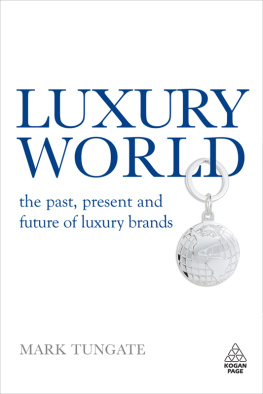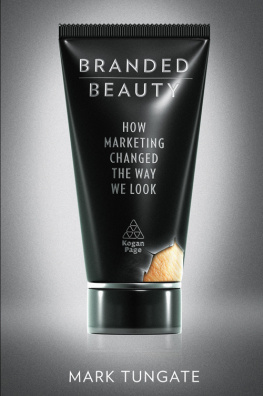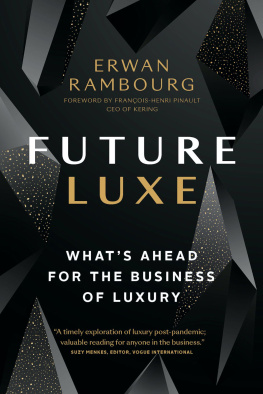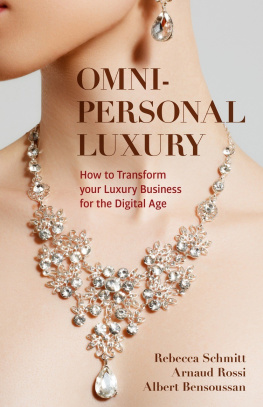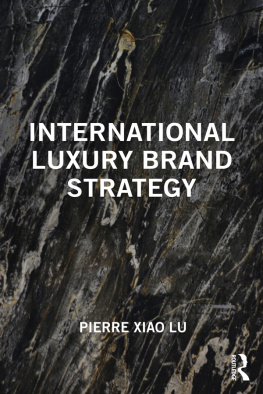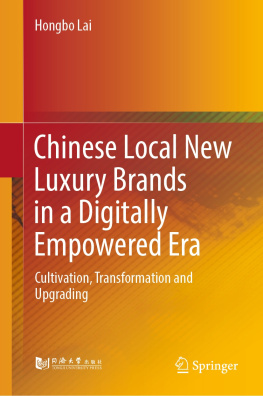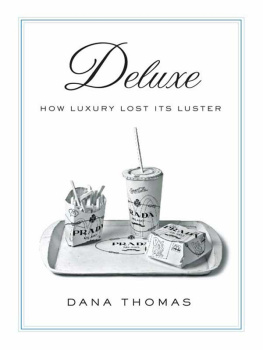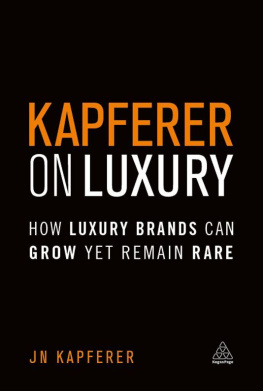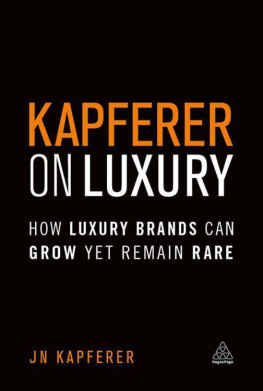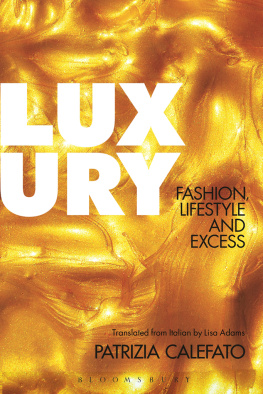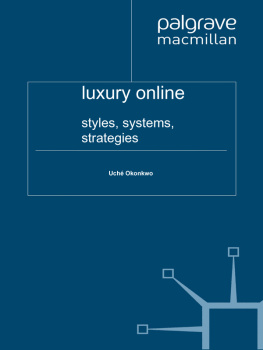LUXURY
WORLD
The past, present and future of luxury brands
MARK TUNGATE

Publishers note
Every possible effort has been made to ensure that the information contained in this book is accurate at the time of going to press, and the publishers and authors cannot accept responsibility for any errors or omissions, however caused. No responsibility for loss or damage occasioned to any person acting, or refraining from action, as a result of the material in this publication can be accepted by the editor, the publisher or any of the authors.
First published in Great Britain and the United States in 2009 by Kogan Page Limited
Apart from any fair dealing for the purposes of research or private study, or criticism or review, as permitted under the Copyright, Designs and Patents Act 1988, this publication may only be reproduced, stored or transmitted, in any form or by any means, with the prior permission in writing of the publishers, or in the case of reprographic reproduction in accordance with the terms and licences issued by the CLA. Enquiries concerning reproduction outside these terms should be sent to the publishers at the undermentioned addresses:
120 Pentonville Road | 525 South 4th Street, #241 |
London N1 9JN | Philadelphia PA 19147 |
United Kingdom | USA |
www.koganpage.com |
Mark Tungate, 2009
The right of Mark Tungate to be identified as the author of this work has been asserted by him in accordance with the Copyright, Designs and Patents Act 1988.
ISBN 978 0 7494 5263 6
E-ISBN 978 0 7494 5856 0
British Library Cataloguing-in-Publication Data
A CIP record for this book is available from the British Library.
Library of Congress Cataloging-in-Publication Data
Tungate, Mark, 1967
Luxury world: the past, present and future of luxury brands / Mark Tungate.
p. cm.
Includes bibliographical references and index.
ISBN 978-0-7494-5263-6
1. Luxury goods industry. 2. Brand name products. 3. LuxuriesHistory. I. Title.
HD9999.L852T86 2009
338.47dc22
2009027020
Typeset by JS Typesetting Ltd, Porthcawl, Mid Glamorgan
Printed and bound in Great Britain by MPG Books Ltd, Bodmin, Cornwall
eBook by Graphicraft Limited, Hong Kong
For Graldine.
Or perhaps I should say, for
Madame Graldine Dormoy-Tungate.
It was a very good year.
Contents
The great luxury of working on a project like this is that you arent on your own in fact, you are obliged to get in touch with a wide variety of advisors and facilitators. On that score, Id particularly like to thank Francesca Barba, who not only looked after me in Monaco, but also introduced me to several people who specialize in serving the very wealthy. A warm word of thanks, too, to Paul Coleman, whose excellent contacts led to two valuable interviews. Similarly, the persistence of Alexandre Wehrlin at Piaget made my visit to that company possible. Evelyne Resnick uncorked her extensive knowledge of wine. Genevieve Flaven of S-Vision was on hand, as ever, to provide advice and inspiration. I also owe a debt of gratitude to Jon Finch at Kogan Page, who remained patient in the face of missed deadlines. And of course none of it would be worth doing without Graldine, whose love and support have a value beyond measure.
Finally, thanks to all my interviewees. They will find their names in the pages that follow. Here are those who worked behind the scenes: Anais Caietta, Joanna Derain, Iris le Floch, Piyatchat Jiemvitayanukul, Alix Leonard-Morgan, Julia Marozzi, Karin de Mulder, Monica Paolazzi, Waike Papke, Emanuelle Perrier, Jimmy Pihet, Carole de Poix, Laetizia Saubesty, Alexia Uri. I wish you all the best of luxe.
I cant afford to buy cheap things.
Its 10 am on a sunny Sunday morning and for once the Avenue des Champs Elyses is quiet. Normally the distant Arc de Triomphe is obscured by a haze of exhaust fumes rising from two crawling lines of traffic, but today the view up the avenue from the Place de la Concorde is diamond clear. One can almost imagine tumbleweed blowing across the attractively cobbled thoroughfare.
The avenue is not entirely deserted, however. A motorcade of three large black automobiles makes its stately way to the Louis Vuitton flagship store at the corner of Avenue George V. The cars sigh to a halt outside the emporium, which has been specially opened for the occasion. A uniformed chauffeur emerges and opens the rear door of the middle car. From its cool dark interior emerges a vision in a cerise velour tracksuit. The tiny figures neck and wrists are weighed down with gold jewellery. In her arms, she cradles a chihuahua. The girl is barely 17 years old, and she is a princess from one of the Gulf States.
The princess is escorted into the store, where a personal shopper is on hand to help her. Although he speaks a handful of languages, his linguistic skills are not required. When the princess sees something she likes, she simply points. By the time she has left the store, she has spent tens of thousands of euros.
This incident sketched from life, with only minor embellishments captures the essence of the luxury industry: an elite brand doing its utmost to provide a personalized service to a high-spending client. For most of us, the world inhabited by the princess is impossibly distant from our daily lives. And yet every year luxury brands spend millions trying to convince us otherwise.
Theyve been at it for a long time. Certainly since the turn of the last century, when couturiers who made wildly expensive dresses for a narrow market of wealthy women began to diversify in order to boost their incomes. The fashion designer Poiret launched a perfume called Rosine named after his eldest daughter in 1911. Chanel No 5 was created in 1921. The house of Worth launched another famous fragrance, Je Reviens, in 1932. These pretty glass bottles were prisms through which everyday consumers could glimpse a life of luxury. Other accessories followed. In the 1970s, Cartier launched a range of affordable trinkets called Les Must: lighters, pens, watches and key rings, all trafficking the jewellers premium values.
At the beginning of the 21st century, when established luxury brands fell into the hands of giant corporations with profit-hungry shareholders, this courtship of the mass market accelerated and intensified. Sunglasses, sneakers, scarves, belts and billfolds: lower-priced items put luxury tantalizingly within our reach. We found that we could enter the Louis Vuitton store on the Champs Elyses, purchase a relatively affordable gift (say, a US $260 monogrammed passport cover) and be treated with only slightly less deference than the teenage princess. The crystal-encrusted tentacles of luxury descended to caress our souls, and we grasped them.
This development changed the luxury game. As Michel Chevalier and Grald Mazzalovo observed in their 2008 book Luxury Brand Management, the traditional definition of a luxury brand was one that was selective and exclusive... almost the only brand in its category, giving it the desirable attributes of being scarce, sophisticated and in good taste. The scarcity and aristocratic dimension of these brands went hand in hand with a lofty price tag, making them inaccessible to most people. But with the democratization of luxury, that definition had evolved. The sophistication remained, but the selectivity was less apparent. Now there were two sorts of luxury: the inaccessible and the mass. The factors that bound them were an additional creative and emotional value for the consumer and the promise of quality which was occasionally fulfilled.

